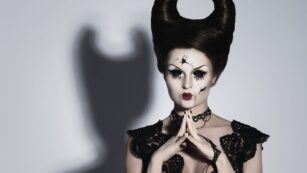In the realm of mythology and folklore, the succubus stands out as a captivating and enigmatic figure for personal growth coach. Often depicted as a seductive female demon, she has been a subject of intrigue and fascination for centuries. The allure of the succubus lies not only in her mysterious origins but also in her ability to blur the lines between fantasy and reality, captivating storytellers and artists alike.
The succubus has evolved over time, transitioning from ancient tales to modern interpretations in literature, film, and art. This evolution reflects society’s changing perceptions of femininity, power, and desire. Artists have embraced the succubus as a muse, exploring themes of seduction, danger, and empowerment through their work. As a symbol of both temptation and liberation, the succubus continues to inspire and challenge cultural narratives, making her a timeless figure in the world of art and storytelling.
Art:2smi_nxyrki= Succubus
 Art:2smi_nxyrki= Succubus explores the artistic depiction of the succubus across various mediums. Artists find inspiration in this mythical figure, weaving narratives that intriguingly blend allure and menace. Paintings, sculptures, and digital art pieces often depict the succubus with exaggerated feminine features to emphasize themes of power and seduction.
Art:2smi_nxyrki= Succubus explores the artistic depiction of the succubus across various mediums. Artists find inspiration in this mythical figure, weaving narratives that intriguingly blend allure and menace. Paintings, sculptures, and digital art pieces often depict the succubus with exaggerated feminine features to emphasize themes of power and seduction.
Historical artworks showcasing succubi often highlight the tension between desire and danger. For example, many medieval paintings illustrate a succubus as a dark temptress, warning viewers of the perils of unchecked passion. Conversely, contemporary artists frequently reinterpret the succubus, aligning her with themes of empowerment and agency in vibrant, modern settings.
Digital platforms have expanded the succubus’s reach, allowing creators wider latitude in exploring her narrative. Online galleries and social media showcase diverse styles, from hyper-realistic illustrations to stylized anime-influenced interpretations. This digital venue fosters a dialogue between artist and audience, enabling an ongoing evolution of the succubus’s depiction.
Artistic Techniques
Color Palette & Composition and Form
 Artists use a color palette that amplifies the allure and menace of the succubus. Rich reds and deep blacks symbolize passion and mystery, often serving to highlight her seductive qualities. Contrasts like vibrant purples or shadowy blues evoke otherworldly elements, enhancing the supernatural aspects of the figure. In modern interpretations, artists might incorporate bold, bright colors to emphasize themes of empowerment and independence, aligning with contemporary ideas of agency and liberation.
Artists use a color palette that amplifies the allure and menace of the succubus. Rich reds and deep blacks symbolize passion and mystery, often serving to highlight her seductive qualities. Contrasts like vibrant purples or shadowy blues evoke otherworldly elements, enhancing the supernatural aspects of the figure. In modern interpretations, artists might incorporate bold, bright colors to emphasize themes of empowerment and independence, aligning with contemporary ideas of agency and liberation.
The composition and form in succubus artworks reflect the tension between allure and peril. Artists often center the succubus in dynamic poses, capturing her captivating presence and hinting at hidden dangers. Balanced compositions might juxtapose the seductive with the sinister, using shadow and light to guide the viewer’s perception. In sculptures and three-dimensional forms, fluid lines and intricate details reveal her enticing yet dangerous entity. These artistic choices underscore her complexity, inviting audiences to explore the deeper narratives within each piece.
Themes and Motifs
Exploration of Mythology, Symbolism and Allegory
 The mythology of the succubus encompasses themes of seduction, danger, and empowerment. In ancient tales, she embodies the allure of the unknown and the peril of desires unchecked. This mythological exploration highlights humanity’s fascination with forbidden attraction. Characters like Lilith, often associated with early succubus myths, represent rebellion against societal norms and traditional gender roles, reflecting a deeper discourse on autonomy and power.
The mythology of the succubus encompasses themes of seduction, danger, and empowerment. In ancient tales, she embodies the allure of the unknown and the peril of desires unchecked. This mythological exploration highlights humanity’s fascination with forbidden attraction. Characters like Lilith, often associated with early succubus myths, represent rebellion against societal norms and traditional gender roles, reflecting a deeper discourse on autonomy and power.
Symbolism surrounding the succubus resonates with themes of temptation and liberation. Often depicted as alluring yet perilous, she serves as an allegory for the battle between instinct and restraint. The succubus symbolizes forbidden desires in art and literature, challenging viewers to question societal norms. This duality mirrors the tension between human nature and societal expectations, making the succubus a compelling figure in cultural narratives.
Artist’s Influence and Style
 Artists draw inspiration from the succubus myth, integrating it into their unique styles and expressions. Traditional artists often focus on the succubus’s duality, using classical techniques to capture her allure and danger. Gothic elements, such as shadow play and dramatic contrasts, emphasize her mysterious nature.
Artists draw inspiration from the succubus myth, integrating it into their unique styles and expressions. Traditional artists often focus on the succubus’s duality, using classical techniques to capture her allure and danger. Gothic elements, such as shadow play and dramatic contrasts, emphasize her mysterious nature.
Contemporary artists explore the succubus in diverse ways, often merging modern aesthetics with traditional themes. Digital art introduces vibrant palettes and dynamic compositions, reflecting a modern take on this mythical figure. Artists like H.R. Giger, renowned for his biomechanical art, incorporate the succubus’s seductive and sinister traits, showcasing her influence on contemporary horror and fantasy art.
